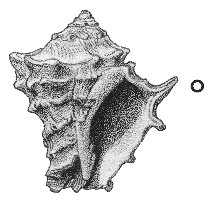
Revised descriptions of New Zealand Cenozoic Mollusca from Beu and Maxwell (1990)

 | Revised descriptions of New Zealand Cenozoic Mollusca from Beu and Maxwell (1990) | 
|
  (Pl. 6o): hypotype of Marwick (1934, pl. 1, fig. 9), locality uncertain but probably Waihao Downs, Bortonian (GNS) |
Beu & Maxwell (1990): Chapter 7; p. 108; pl. 6 o.
Synonymy: Galeodes (Pugilina) liraecostata Suter 1917, p. 19; ?Rapana neozelanica Suter 1917, p. 38-39
Type species of Fascioplex Marwick, 1934
Classification: Melongenidae?; Turbinellidae?
Description: Small for family (height 25-35 mm), biconic, spire low, about 0.25 total height. Protoconch not known. Teleoconch of about 5 strongly clasping whorls in which the sutural ramp extends up to, or slightly below the peripheral keel of the previous whorl. Last whorl with a very prominent peripheral keel and 3-5 well spaced keels of similar or somewhat lesser strength below. Axial sculpture of prominent triangular scale-like spines which are open adaperturally, confined to keels, those on peripheral keel stronger than those below and turned upwards on many specimens; 10 or 11 on penultimate whorl. Last half whorl or so with a subsutural row of very short, closely spaced triangular scales. Spiral sculpture other than keels of numerous threads over whole surface. Aperture ovate with a short, constricted siphonal canal; inner lip thinly callused, outer lip thin, with short internal grooves at positions of keels. Columella concave adapically, twisted to left at inception of siphonal canal; bearing 2 thin, closely spaced plaits on twist. Fasciole prominent, scaly, with a well defined pseudumbilicus between it and inner lip.
Comparison: The relationship of this species to the other two nominal species of Fascioplex, i.e. F. neozelanica (Kakahu) and F. browni (Waihao Downs) remains to be determined. The holotype of F. neozelanica is badly worn, but specimens attributed to this species by Marwick (1934) are similar to F. liraecostata in shape and axial sculpture but lack keels on the base and neck and have a much less prominent fasciole (and consequently a less obvious pseudumbilicus). Nonetheless, it seems probable that the two "species" grade into one another and are not worth separating. F. browni is known only by the holotype, which differs from typical specimens of F. liraecostata in having a much higher spire, axial sculpture of lamellar growth ridges (in addition to peripheral spines) and at least seven prominent spiral cords on base and neck. These differences suggest that F. browni is a distinct species.
Fascioplex is an endemic genus, so far recorded only from the Bortonian, but it resembles (in miniature) Melongena species in the Cenozoic and living faunas of south-eastern USA. However, it differs from Melongena in its prominent columellar plaits, and possibly belongs in Turbinellidae rather than Melongenidae.
Distribution: Bortonian, Waihao Greensand, Kakahu (type of G. liraecostata); "Waihao River" (type of R. neozelanica); South Branch, Waihao River near Waihao Downs; Black Point, Bortons; Pareora River. Moderately common to uncommon at listed localities.
Cite this publication as: "A.G. Beu and J.I. Raine (2009). Revised
descriptions of New Zealand Cenozoic Mollusca from Beu and Maxwell (1990). GNS
Science miscellaneous series no. 27."
© GNS Science, 2009
ISBN
978-0-478-19705-1
ISSN 1177-2441
(Included with a PDF facsimile file
copy of New Zealand Geological Survey Paleontological Bulletin 58 in CD version
from: Publications Officer, GNS Science, P.O. Box 30368 Lower Hutt, New
Zealand)